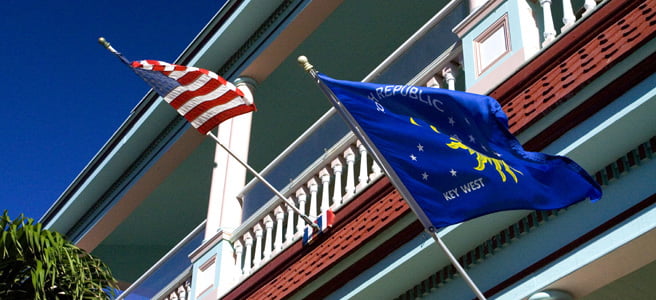Key West Language

English is the official language of Key West, but fun breaks down all language barriers. People from everywhere find a warm island welcome in [brand].
Key West is a Caribbean territory separated from the U.S. mainland, so visitors often wonder about the primary language spoken on the island. In fact, on the streets and in the shops of Key West, it is not unusual to hear any number of different languages in use because even though Key West is small, it is an international tourist destination with millions of people from around the world passing through each year.
Also foundational to the linguistic diversity of the island is its historical background as a site of culture blending. The Native American Calusa people were present on the island when the first European arrived in 1521, Spanish explorer Juan Ponce de León. Florida was then established as a Spanish colony, with Key West being the site of a small garrison and a fishing and salvage village. The name “Key West” may originate from the Spanish Cayo Hueso, or “Bone Cay”, the name given to the island by the Spaniards reportedly in reference to the bones of Native Americans that littered the island. Modern Spanish-speaking people still refer to Key West by this name, and “Key West” is thought to be an anglicization of Cayo Hueso.
English arrived as the official language of the island when the Kingdom of Great Britain took control of Florida in 1763. When Florida returned to Spanish control 20 years later, there was no official Spanish resettlement of Key West, so free reign was given to a polyglot mixture of English, Spanish, various Caribbean patois, and other languages brought to the island by mariners and settlers. The original Conchs, black and white settlers who arrived from the Bahamas to settle the island in the early 1820s, brought a distinctive Caribbean English patois that blended a Southern drawl with a New England twang and spiced it with Spanish picked up through intermarriage as the generations went by.
A prominent Spanish influence has been continuously retained in Key West because, given its proximity to Cuba, the island was traditionally a port of call for Spanish-speaking Cuban fishermen. Moreover, immigration has landed many more Cubans in Key West from the 1800s onward. Refugees from Cuba and Haiti continue to arrive to this day, bringing fresh injections of Spanish and French-Caribbean Creole to the island.
In modern times, the economic boom of the two decades prior to the global recession of 2008 brought many international workers to Key West. The large resorts as well as other businesses experienced labor shortages during this time and recruited abroad, beginning with the Casa Marina and two other luxury resorts that used a recruiting company to hire housekeepers from among the Polish immigrant communities in Buffalo and Chicago. The Poles were followed by Czechs, Ukrainians, Uzbekistanis, Africans, and many others, all attracted by an abundance of jobs in the booming tourist industry. With the workers came their native languages, resulting in the rich mix that can be heard in the streets and cafes of Key West today.
As far as your visit to Key West is concerned, it is an American city, so the most common language in use is English. Spanish is also fairly common, and some signage, ATM screens, tourism materials, and package labels feature Spanish as well as English. Specific facilities and establishments may also offer signage or translation support for other languages as well, on a case-by-case basis. The Monroe County Tourist Development Council sponsors a free multi-lingual assistance telephone line (1-800-771-KEYS) that provides visitors 24/7 native language help with any questions or problems they may encounter during their Florida visit. In addition, the council’s website features a foreign language tourism page with videos and brochures in French, German, Japanese, Portuguese, Spanish, and Swedish.
Key West is a welcoming place, and tourists with limited English language capabilities will not encounter any major difficulties. Island locals are used to dealing with people who speak English as a second language, and a combination of goodwill, body language, and a smile should be more than adequate for communication in most situations. Come to Key West for a visit and let https://www.coolkeywest.com show you that people really are cool in Key West, where the universal language of music and love is the lingua franca.

































